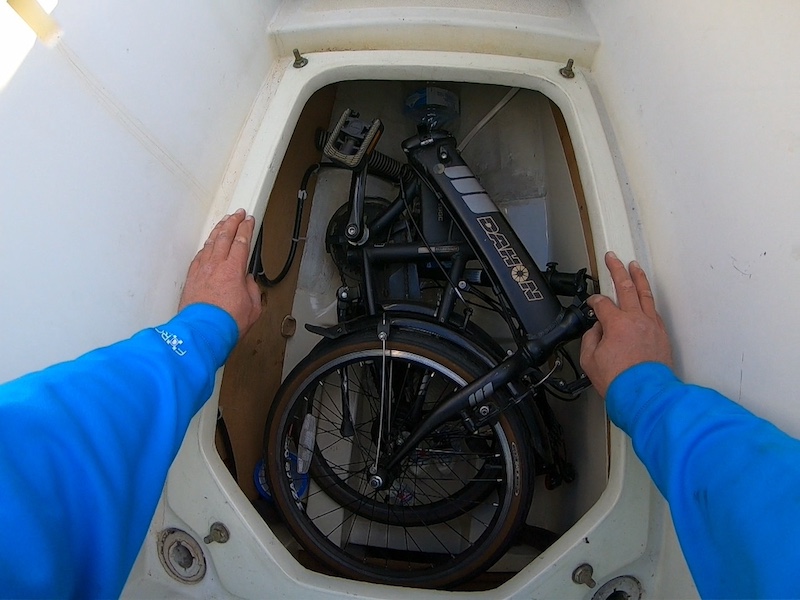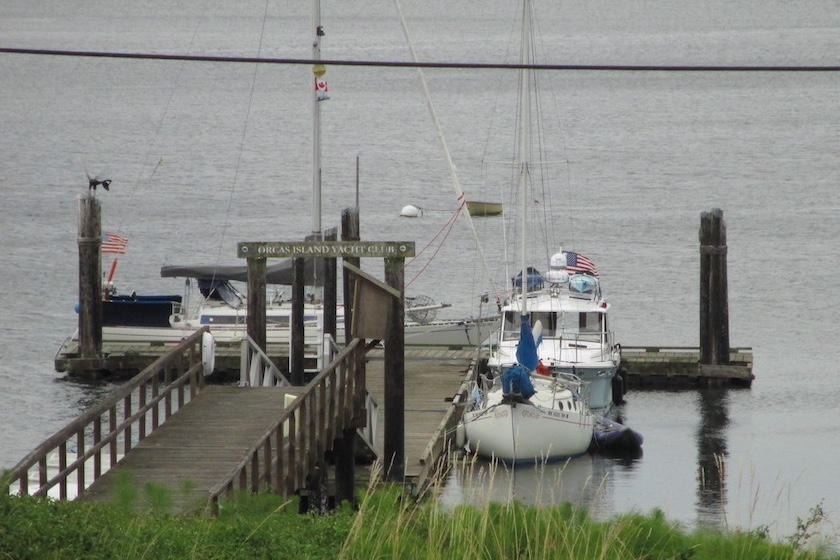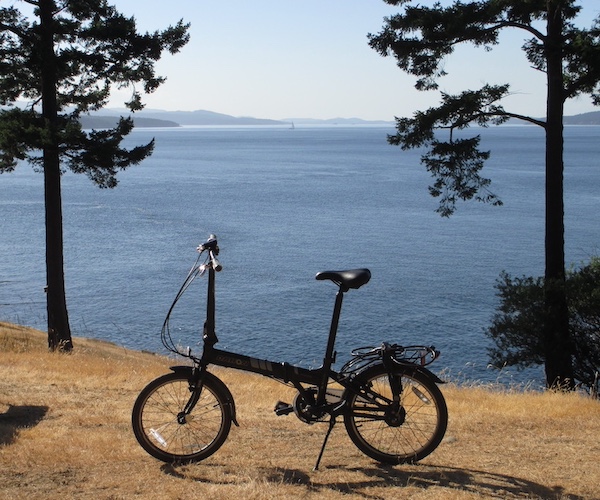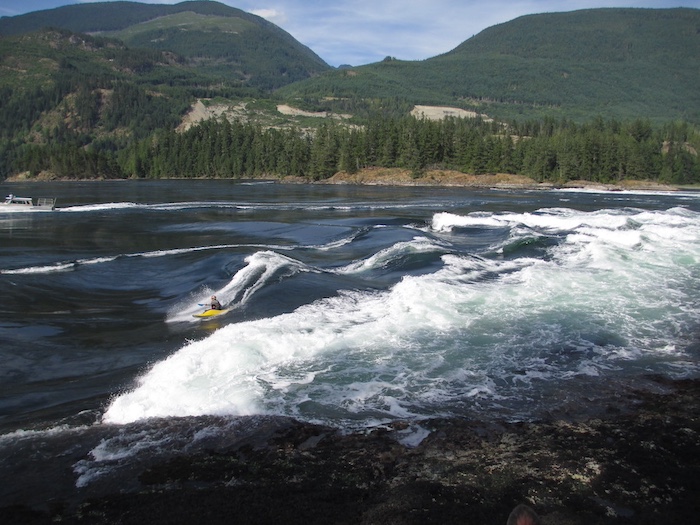
The Resourceful Sailor and the Circus Bike
And now for something completely different … from our favorite sailing MacGyver, we bring you The Resourceful Sailor’s adventures aboard his Circus Bike.
My landlubber friends sometimes snickered at me when I rode my folding bike. I hope it’s the bike that was drawing the attention. When compared to a conventional one, the proportions were all wrong. The wheels were small, like on a BMX bike, but the frame was trying to be adult-sized with high-rise extensions for the handlebars and the seat. That’s why I’d taken to calling it the Circus Bike. I didn’t ride it around the hometown much, reserving it for trips aboard Sampaguita, in particular voyages throughout Puget Sound, the San Juans, the Gulf Islands, and the Sunshine Coast. It was a convenient tool, a time-saver, and good exercise and entertainment. If you are considering carrying a bicycle on board, I offer these stories with the Circus Bike as an account of possibilities.
Why did I buy a folding bike to carry aboard my boat?
When I purchased Sampaguita, a Pacific Seacraft Flicka 20, in 2013, the seller offered a folding bike and a Montgomery 7-11 dinghy with the sale. The bike was in excellent condition, and the dinghy had a sailing rig. I hadn’t considered having either before, but the price was right. I could sell them if they didn’t work out.
Now I have a bike, where do I put it?
Following the previous owner’s lead, I initially stored the Circus Bike lashed on the settee next to the companionway. I quickly grew tired of looking at it, and it took up valuable cabin space. If I forgot to lash it, it would crash onto the sole. After the second time, I’d had enough. A Flicka’s diminutive size limits the options, but since Sampaguita didn’t have an inboard motor, I wondered if the Circus Bike might fit into that engine space.

Huh? How do I do that?
Here is where it gets very builder-specific. Pacific Seacrafts have a removable cockpit sole held down with four knurled knobs. While this gives full access to the engine space from above, it is an awkward reach. Standing inside the cabin and leaning against the companionway ladder, facing aft, I could reach over the bridge and leverage my lower body off the bulkhead and ladder to lift the bike in and out. After trial and error, I found a way to angle in the Circus Bike. It took some shuffling around the other gear I stowed in there, but everything still fit. I added some padding to protect the contact spots.

When did I use it?
Having a bike paid off when I was tied to a dock. Fetching gasoline for Sampaguita’s outboard with jerry cans could be simpler and faster than moving the boat to a fuel dock. Pumps aren’t always close, are sometimes broken, and sometimes are out of fuel. Grocery runs were also great. No cab fare and no waiting. For example, I stayed at the Orcas Island Yacht Club on the West Sound of Orcas Island, where there are no services. I rode the bike to East Sound, six miles away, for fuel and groceries. And the Orcas Island countryside is beautiful.

What else?
I needed to top off my propane tank before I headed up to Princess Louisa Inlet one summer. I had aimed to do this in Port Townsend, but the propane station was out of order. I waited until Nanaimo, but the closest filling station was two miles inland. I was informed taxis may consider a propane tank dangerous cargo and refuse service. Since everything on a Flicka is small, I had a 1.4-gallon, tall, slim Worthington tank. It fit in my backpack. I used the Circus Bike to get to the station and back. It felt a little dangerous, like riding a bike with a bomb on my back, but likely only marginally more dangerous than a car, and it worked great.
Is it only for work?
No, not at all. I have explored many islands and peninsulas on the Circus Bike: Lopez, San Juan, Orcas, Stuart, and South Pender islands, for example. While docked in Prevost Harbor on Stuart Island, I did a six-mile round trip to Turn Point Lighthouse. The bike did well, considering the dirt trail, washouts and hills. I wouldn’t have had time to make the trip without the bike.

In Egmont, British Columbia, the bike first served for two gas runs to town. Back Eddy Resort’s gas pump, where I was staying, was broken. (I don’t need to make this stuff up.) I then rode most of the way to Skookumchuck Narrows to watch the kayakers ride the standing waves in the Sechelt tidal rapids — a seven-mile round trip. The Circus Bike got me to the rapids in time for the maximum flood and home for the sunset.

What about at anchor?
All of my bike experiences have been with Sampaguita moored to a dock. I used an inflatable kayak when at anchor. The kayak was stable, but transporting the bike felt insecure. I was nervous about it going into the water.
What about the Montgomery?
It was too big for long journeys with the Flicka. It always had to be towed, so I’d sold it to buy the kayak.
If you have a small boat and can find an acceptable place to store a bike aboard, it could expand your shoreside possibilities when cruising. Each boat will require its unique approach to storage, but that’s part of the fun of messing about. Whether it be for running errands or exploring, you will be able to travel farther and faster. The Circus Bike had a bike rack, so I could strap on a small jerry can or a box of groceries, and wear a backpack.
Folding bikes look a bit weak to an avid rider, but they are surprisingly strong. Since I reserved its use for cruising on Sampaguita, and as a backup for my regular, land-based bike, little maintenance was required. I did add a shim to one of the folding latches for a more secure fit, and kept the chain lubricated. Since I stored it inside, out of the elements, salt was not an issue.
Remember, keep your solutions prudent and safe, and have a blast.
